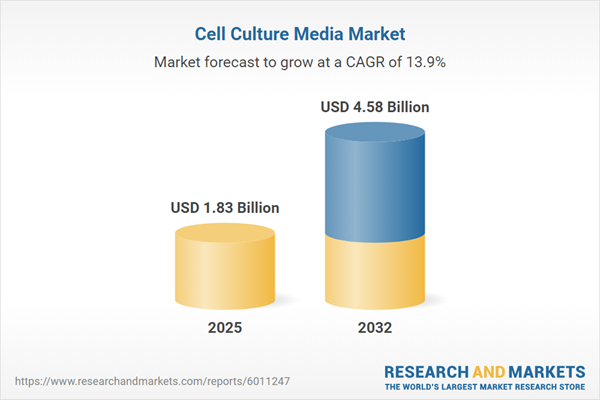Speak directly to the analyst to clarify any post sales queries you may have.
The cell culture media market is evolving rapidly, shaped by scientific advancements and responsive strategies from key industry participants. This report provides decision-makers with essential insights to navigate regulatory shifts, emerging trends, and operational complexities in the global cell culture media landscape.
Market Snapshot: Cell Culture Media Market Overview
The cell culture media market grew from USD 1.61 billion in 2024 to USD 1.83 billion in 2025. It is projected to expand at a CAGR of 13.92%, reaching USD 4.58 billion by 2032. This growth trajectory is driven by expanding applications across biologics manufacturing, regenerative medicine, and life science research. Higher quality standards, responsible ingredient sourcing, and digitalization are also contributing factors. Stakeholders are adapting to evolving demands, tapping into trends that drive both scientific discovery and commercial success.
Scope & Segmentation
- Product Type: Serum-Containing Media, Serum-Free Media
- Cell Type: Mammalian Cell Culture Media, Microbial and Insect Cell Culture Media, Plant Cell Culture Media
- Form: Liquid Media, Powdered Media
- Application: Bioprocessing and Production, Drug Discovery and Testing, Research and Development, Tissue Engineering and Regenerative Medicine
- End User: Academic and Research Institutes, Contract Research Organizations, Pharmaceutical and Biotechnology Companies
- Regions: Americas (United States, Canada, Mexico, Brazil, Argentina, Chile, Colombia, Peru), Europe (United Kingdom, Germany, France, Russia, Italy, Spain, Netherlands, Sweden, Poland, Switzerland), Middle East (United Arab Emirates, Saudi Arabia, Qatar, Turkey, Israel), Africa (South Africa, Nigeria, Egypt, Kenya), Asia-Pacific (China, India, Japan, Australia, South Korea, Indonesia, Thailand, Malaysia, Singapore, Taiwan)
- Key Companies: Thermo Fisher Scientific Inc., Merck KGaA, Danaher Corporation, Lonza Group Ltd., Corning Incorporated, Sartorius AG, FUJIFILM Wako Pure Chemical Corporation, Takara Bio Inc., Becton, Dickinson and Company, Biological Industries Israel Beit Haemek Ltd.
Key Takeaways: Strategic Insights for Decision-Makers
- Demand for reproducible and scalable cell culture media solutions is intensifying, as manufacturers seek to balance quality, regulatory compliance, and cost efficiency.
- Technological advances in chemically defined and xeno-free media are helping minimize variability, support new therapeutic modalities, and reduce reliance on animal-derived components.
- Automation and artificial intelligence are transforming formulation workflows, driving faster development and more precise nutrient optimization across research and bioproduction.
- Regional manufacturing capabilities, especially in Asia-Pacific, are strengthening supply chain resilience and supporting government-driven life science initiatives.
- Collaborative agreements and portfolio diversification remain active strategies for market leaders striving to address niche demands, such as stem cell research and sustainable packaging.
- Environmental sustainability and energy efficiency are becoming central to corporate strategies, in response to expectations from end users and global regulatory frameworks.
Tariff Impact: Navigating 2025 United States Trade Policy
The introduction of United States tariffs in 2025 has influenced cost structures and reshaped supply chain planning for cell culture media producers. Many entities are exploring long-term sourcing agreements, nearshoring, and regional inventory optimization to mitigate rising import costs and ensure business continuity. Pricing negotiations have become more transparent, and flexible logistical models are prioritized to maintain consistent access to essential inputs.
Methodology & Data Sources
This report synthesizes primary expert interviews with secondary data analysis to ensure a robust, reliable perspective. The methodology incorporates insights from industry scientists, engineers, and regulatory professionals, complemented by the review of technical literature, company disclosures, and analytical frameworks. Segmentation and regional trends have been validated through iterative consultations with subject matter experts.
Why This Report Matters
- Enables leaders to identify growth opportunities through targeted segmentation analysis and actionable competitive intelligence.
- Equips strategic planners with early signals on regulatory, technological, and tariff-related shifts affecting global supply chains and market adoption.
- Supports evidence-based investment decisions by highlighting innovation pipelines, R&D priorities, and evolving end-user demands across all major geographies.
Conclusion
The cell culture media market is characterized by innovation, regulatory complexity, and regional diversity. Informed strategies will help industry stakeholders navigate changing demands and seize emerging opportunities for sustainable growth.
Additional Product Information:
- Purchase of this report includes 1 year online access with quarterly updates.
- This report can be updated on request. Please contact our Customer Experience team using the Ask a Question widget on our website.
Table of Contents
3. Executive Summary
4. Market Overview
7. Cumulative Impact of Artificial Intelligence 2025
Companies Mentioned
The companies profiled in this Cell Culture Media market report include:- Thermo Fisher Scientific Inc.
- Merck KGaA
- Danaher Corporation
- Lonza Group Ltd.
- Corning Incorporated
- Sartorius AG
- FUJIFILM Wako Pure Chemical Corporation
- Takara Bio Inc.
- Becton, Dickinson and Company
- Biological Industries Israel Beit Haemek Ltd.
Table Information
| Report Attribute | Details |
|---|---|
| No. of Pages | 199 |
| Published | October 2025 |
| Forecast Period | 2025 - 2032 |
| Estimated Market Value ( USD | $ 1.83 Billion |
| Forecasted Market Value ( USD | $ 4.58 Billion |
| Compound Annual Growth Rate | 13.9% |
| Regions Covered | Global |
| No. of Companies Mentioned | 11 |









